
Leucanthemum vulgare, commonly known as the ox-eye daisy, oxeye daisy, dog daisy, marguerite and other common names, is a widespread flowering plant native to Europe and the temperate regions of Asia, and an introduced plant to North America, Australia and New Zealand.

Xerochrysum bracteatum, commonly known as the golden everlasting or strawflower, is a flowering plant in the family Asteraceae native to Australia. Described by Étienne Pierre Ventenat in 1803, it was known as Helichrysum bracteatum for many years before being transferred to a new genus Xerochrysum in 1990. It is an annual up to 1 m (3.3 ft) tall with green or grey leafy foliage. Golden yellow or white flower heads are produced from spring to autumn; their distinctive feature is the papery bracts that resemble petals. The species is widespread, growing in a variety of habitats across the country, from rainforest margins to deserts and subalpine areas. The golden everlasting serves as food for various larvae of lepidopterans, and adult butterflies, hoverflies, native bees, small beetles, and grasshoppers visit the flower heads.

Xerochrysum is a genus of flowering plants native to Australia. It was defined by Russian botanist Nikolai Tzvelev in 1990, preceding Bracteantha which was described the following year. A 2002 molecular study of the tribe Gnaphalieae has indicated the genus is probably polyphyletic, with X. bracteatum and X. viscosum quite removed from each other.

Athertonia is a genus of tall trees, constituting part of the plant family Proteaceae. It is a monotypic taxon, and the sole described species is Athertonia diversifolia, commonly known as Atherton oak. It is a small to medium-sized tree and is endemic to restricted tablelands and mountainous regions of the wet tropics rain forests of north-eastern Queensland, Australia, where it is widespread. For example, it grows in the Atherton Tableland region with which it shares its name, from the colonial pastoralist John Atherton (1837–1913). Its closest relatives are Heliciopsis and Virotia. A relative of the macadamia, it has potential as an ornamental tree and has an edible nut.

Actinotus helianthi, known as the flannel flower, is a common species of flowering plant native to the bushland around Sydney. It was named and first described by the French botanist Jacques Labillardière in his Novae Hollandiae Plantarum Specimen the first general flora of Australia. According to historian Edward Duyker Labillardière could not have collected the type specimen personally and might have received it from Jean-Baptiste Leschenault de La Tour botanist on the expedition of Nicolas Baudin or another early French visitor to New South Wales.

Xerochrysum subundulatum is a flowering plant in the family Asteraceae, native to Australia, growing in Victoria, New South Wales and Tasmania.

Argyranthemum frutescens, known as Paris daisy, marguerite or marguerite daisy, is a perennial plant known for its flowers. It is native to the Canary Islands. Hybrids derived from this species are widely cultivated as ornamental plants in private gardens and public parks in many countries, and have naturalized in Italy and southern California. There are many cultivars, but the most common has white petals.
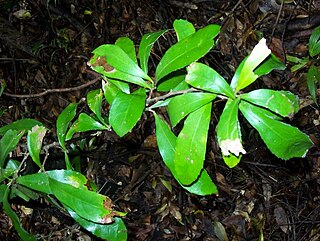
Helicia glabriflora is a species of rainforest shrubs or small trees occurring in eastern Australia. Common names include smooth or pale helicia, pale, leather or brown oak. They grow naturally in a variety of different rainforest types from the Illawarra, New South Wales to the Townsville area, Queensland. Of all the global diversity of approximately one hundred Helicia species, this one species naturally grows the furthest south, in the Minnamurra Rainforest and the Robertson area, Illawarra, New South Wales, there observed more on the relatively fertile basalt and alluvial soils.
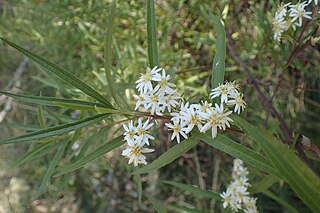
Olearia viscidula, commonly known as the viscid daisy bush or wallaby weed, is a species of flowering plant in the family Asteraceae and is endemic to eastern New South Wales. It is a shrub with scattered narrow elliptic or egg-shaped leaves that are paler on the lower surface, and panicles of white flowers arranged in leaf axils.

Olearia tomentosa, commonly known as the toothed- or downy daisy bush, is a shrub or subshrub species in the family Asteraceae.

Xerochrysum bicolor is a flowering plant in the family Asteraceae, native to Tasmania, where it is found in wetter habitats near the coast. It was originally described by Lindley in 1835 as Helichrysum bicolor, before gaining its current name in 2001.

Coronidium elatum, commonly known as the white paper daisy or tall everlasting, is a perennial herbaceous shrub in the family Asteraceae found in open forests in eastern Australia. A woody shrub 0.6 to 2 m tall, it has white flowers which appear in spring. It was known as Helichrysum elatum for many years until it was finally reviewed in 2008.

Olearia erubescens, commonly known as moth daisy-bush or pink-tip daisy-bush, is a species of flowering plant in the family Asteraceae. It is a shrub with stiff, prickly leaves and white "daisy" flowers, growing up to 2 metres high.

Olearia asterotricha, commonly known as rough daisy-bush, is a species of flowering plant in the family Asteraceae. A tall shrub with white, mauve or blue daisy like flowers growing from the Blue Mountains in New South Wales to western Victoria, Australia.

Brachyscome graminea, commonly known as grass daisy, is a perennial herb in the family Asteraceae and is endemic to Australia. It has mostly mauve-pink or purple daisy-like flowers and a yellow centre.
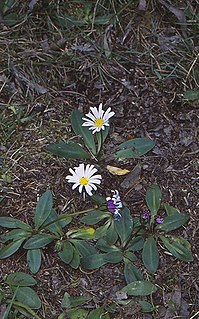
Brachyscome decipiens, commonly known as field daisy is a perennial herb in the family Asteraceae and is endemic to Australia. It is a small herb with white or pale blue flowers.
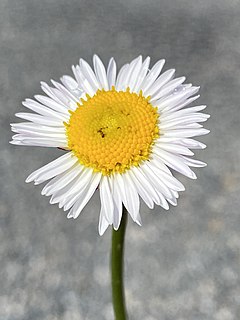
Brachyscome nivalis, commonly known as snow daisy, is a perennial herb in the family Asteraceae and is endemic to Australia. It has mostly white daisy-like flowers, yellow centres and deeply lobed leaves.
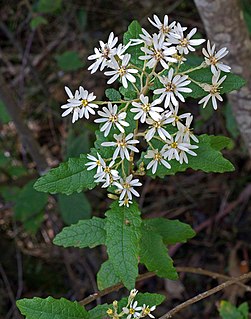
Olearia rugosa, commonly known as wrinkled daisy-bush, is a species of flowering plant in the family Asteraceae. It has alternate, wrinkled leaves and white daisy-like flowers and is endemic to Victoria.

Olearia calcarea, commonly known as limestone daisy bush, is a species of flowering plant in the family Asteraceae and is endemic to southern continental Australia. It is a shrub with egg-shaped or broadly spoon-shaped leaves with toothed edges, and white and yellow, daisy-like inflorescences.

Olearia grandiflora, commonly known as Mount Lofty daisy-bush, is a species of flowering plant in the family Asteraceae and is endemic to a restricted area of South Australia. It is a spreading shrub with egg-shaped leaves and white and yellow, daisy-like inflorescences.


















